On Friday, as we traveled to the Fall Reunion/Meeting of the Brooks Bird Club, our first stop was for an early lunch at Coleman’s Fish Market in Wheeling, WV, for “the world’s best fish sandwich” and scrumptious lobster bisque soup.
After we arrived at Cedar Lakes Conference Center in Ripley, WV, Jan was immediately involved in a meeting. I, of course, went hiking. One of the first things I found was a leaf rosette of Great Mullein (𝑉𝑒𝑟𝑏𝑎𝑠𝑐𝑢𝑚 𝑡ℎ𝑎𝑝𝑠𝑢𝑠).

There were Pawpaw (𝐴𝑠𝑖𝑚𝑖𝑛𝑎 𝑡𝑟𝑖𝑙𝑜𝑏𝑎) groves in many places with lots of young trees around the older ones.
The cones and branches of Virginia Pine (𝑃𝑖𝑛𝑢𝑠 𝑣𝑖𝑟𝑔𝑖𝑛𝑖𝑎𝑛𝑎) had fallen everywhere along the trail, possibly from a wind storm which blew through earlier in the year. There was life everywhere – trees, herbaceous plants, squirrels, and a multitude of bird chips, calls and some songs.
My mind must have been on up-coming Halloween since, in fallen branches and tree stumps, I saw spooky nature patterns and even imaginary faces.
There wasn’t a lot of fall color, but the Flowering Dogwoods (𝐶𝑜𝑟𝑛𝑢𝑠 𝑓𝑙𝑜𝑟𝑖𝑑𝑎) were beginning to change.
In the distance an unusual shade of green caught my attention. It was a beautiful grouping of Pin Cushion Moss (𝐿𝑒𝑢𝑐𝑜𝑏𝑟𝑦𝑢𝑚 𝑔𝑙𝑎𝑢𝑐𝑢𝑚).
This late in the season, plants in flower were nearly impossible to find. However, I did find two nettles in bloom: Clearweed (𝑃𝑖𝑙𝑒𝑎 𝑝𝑢𝑚𝑖𝑙𝑎) and what appeared, at first, to be Wood Nettle (𝐿𝑎𝑝𝑜𝑟𝑡𝑒𝑎 𝑐𝑎𝑛𝑎𝑑𝑒𝑛𝑠𝑖𝑠) except that Wood Nettle has alternate leaves but this nettle had opposite leaves.
That evening I presented the program, “Northern Saw-whet Owl Studies.” Jan and I described our owl research and answered questions.
After breakfast on Saturday a majority of the group went by car caravan in search of birds. Most of the areas they visited were wetlands, water impoundments, streams and rivers in search of waterbirds. I offered to lead a hike on the Bear Claw Trail of Cedar Lakes Conference Center.
Three friends and I headed out on a hike which was about 4 miles long. The beginning of the trail went quickly uphill and the end came back down, but most of the trail was fairly level on a beautiful ridge. To some, hiking means going from point A to point B quickly. On my hikes, we pause to look at just about everything — plants, animals, fallen branches, tree stumps, rocks and everything else. Our off-trail explorations make the distance we travel a lot father than the map shows.
Jan is particularly fond of ferns and we saw several along the hike route.
We found a tiny Camel Cricket (Family: Rhaphidophoridae) nymph exploring the inside a hickory nut shell.
When looking at the wonders of the natural world, it takes a long time to walk a mile.
The trail had occasional patches of Heal-all (𝑃𝑟𝑢𝑛𝑒𝑙𝑙𝑎 𝑣𝑢𝑙𝑔𝑎𝑟𝑖𝑠) growing right in the middle of the path. Each time I saw certain plants, I also visualized their flowers in my mind. Heal-all also goes by many common names: self-heal, woundwort, heart-of-the-earth, carpenter’s herb, bumblebee weed, brownwort or blue curl. Sometimes having so many common names for the same plant can cause confusion.
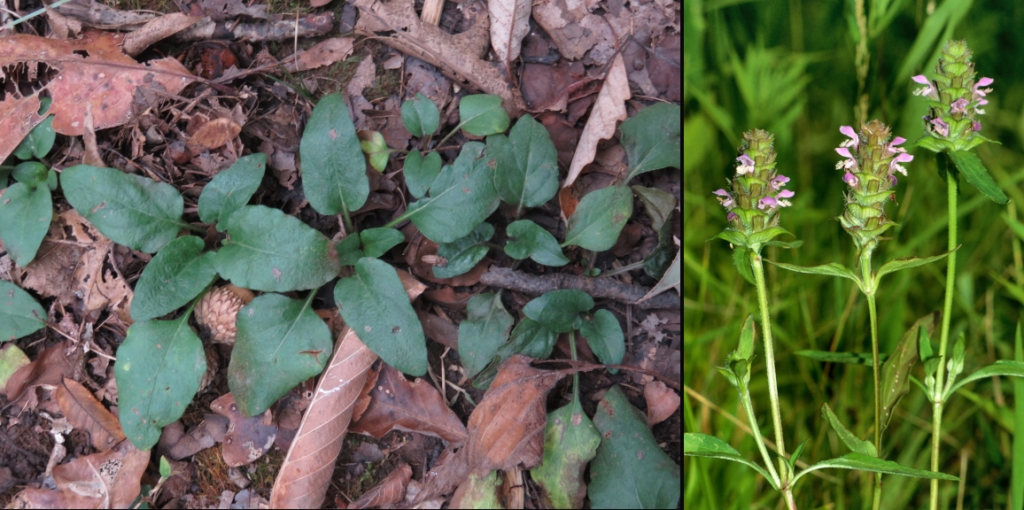
We were surprised by the variety of trees we found, including one we couldn’t identify, until we found the drooping, dried seed clusters around the base of the tree.
We were well into our hike when we noticed several small American Holly (𝐼𝑙𝑒𝑥 𝑜𝑝𝑎𝑐𝑎) trees. Near the end of the hike there were many more, forming thick holly forests on both sides of the trail. Like most of the other plants we found, they had already flowered earlier in the year and all we saw were the leaves.
From time to time we found acorns from several kinds of oaks including Chestnut Oaks (𝑄𝑢𝑒𝑟𝑐𝑢𝑠 𝑚𝑜𝑛𝑡𝑎𝑛𝑎).
Spotted Wintergreen (𝐶ℎ𝑖𝑚𝑎𝑝ℎ𝑖𝑙𝑎 𝑚𝑎𝑐𝑢𝑙𝑎𝑡𝑎) leaves are quite noticeable due to their pronounced white midrib stripe.
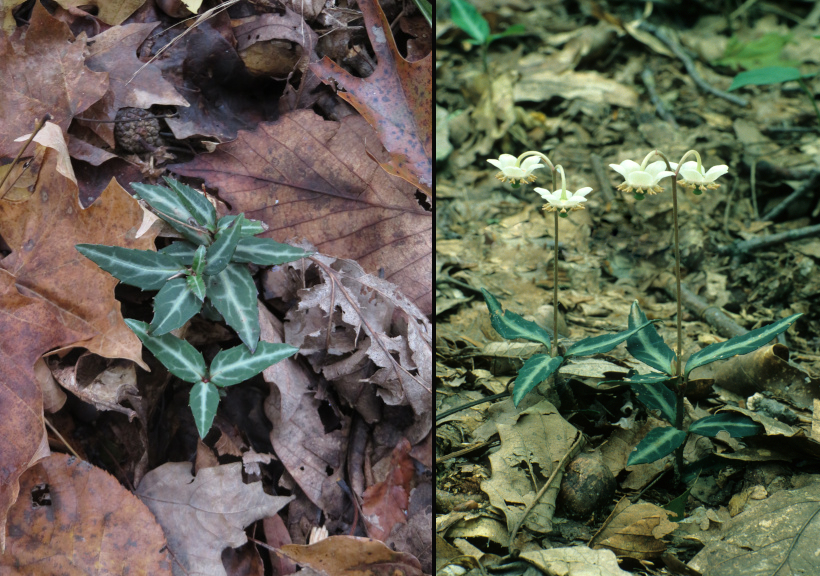
Jan found a Sugar Maple (𝐴𝑐𝑒𝑟 𝑠𝑎𝑐𝑐ℎ𝑎𝑟𝑢𝑚) tree seat for a rest. The heart on the tree was not carved, but appeared to be natural.
We found a huge Sugar Maple hub tree. Hub trees are also called “mother trees”. They are the older trees in the forest. Typically, they have the most fungal connections, their roots are established deeper in the soil, and they can reach deeper sources of water to pass on to younger saplings. This was the largest maple we saw on the hike.
Martin is very good identifying lichens and mosses. We picked his brain with many of the ones we found. Lichens growing on rocks and tree bark indicate clean air. Here he is showing a lichen on tree bark.
Martin identified Palm Tree Moss (𝐻𝑦𝑝𝑛𝑜𝑑𝑒𝑛𝑑𝑟𝑜𝑛 𝑐𝑜𝑚𝑜𝑠𝑢𝑚) for us, and it does look like a tiny palm tree.
“Are we still having fun?” Although, at this point, we had covered 2 trail miles, I wasn’t sure how many exploring miles we had walked. This photo makes me think it might have been too many.
Early in the hike we didn’t notice any fungi, but in the last half we saw many kinds.
We can make it! One more mile to go… sort of.
I was surprised how many interesting creatures we were finding. If we had had the time, more exploring would have yielded so many more finds.
The last event of the day was Tom Pauley’s program of favorite stories about his past students and about reptiles and amphibians of West Virginia. It was excellent!
After the Sunday morning membership meeting and then lunch with special friends in Ripley, Jan and I treated ourselves to dessert at Kirke’s Homemade Ice Cream near home. Favorite flavor? Pumpkin, of course, to go with the beautiful fall season!














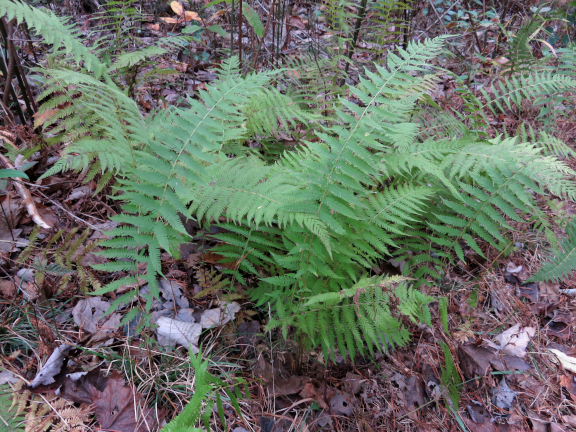







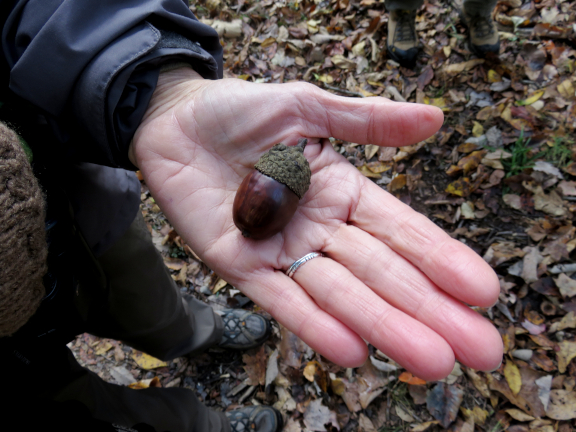
















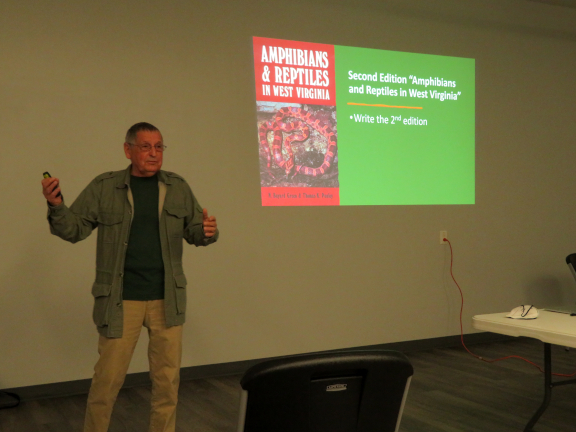

What a wonderful outing! Wish I could still get out and walk those trails with you ❤️
LikeLike
Hi Mary… I wish you could too! … Bill
LikeLike